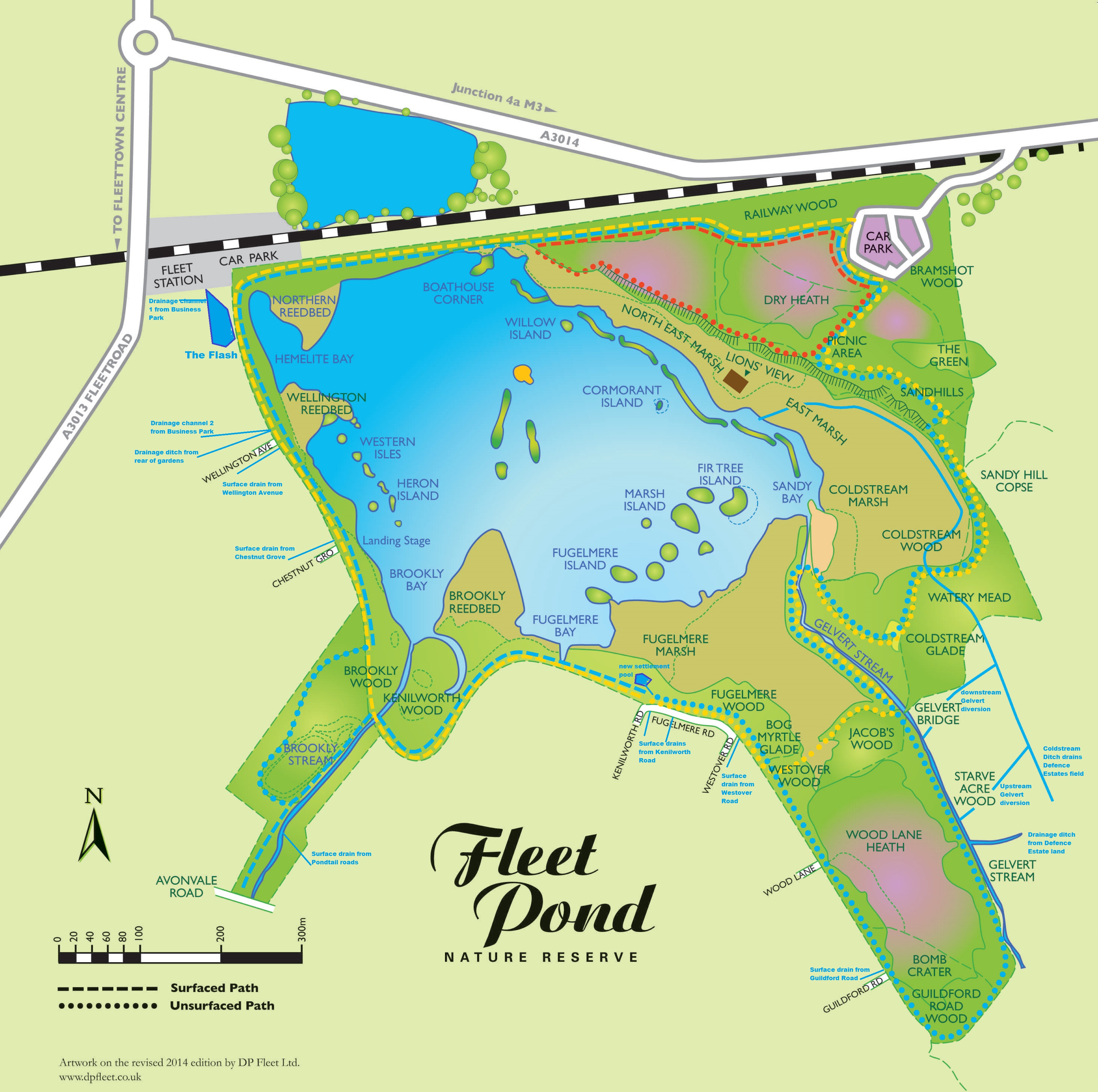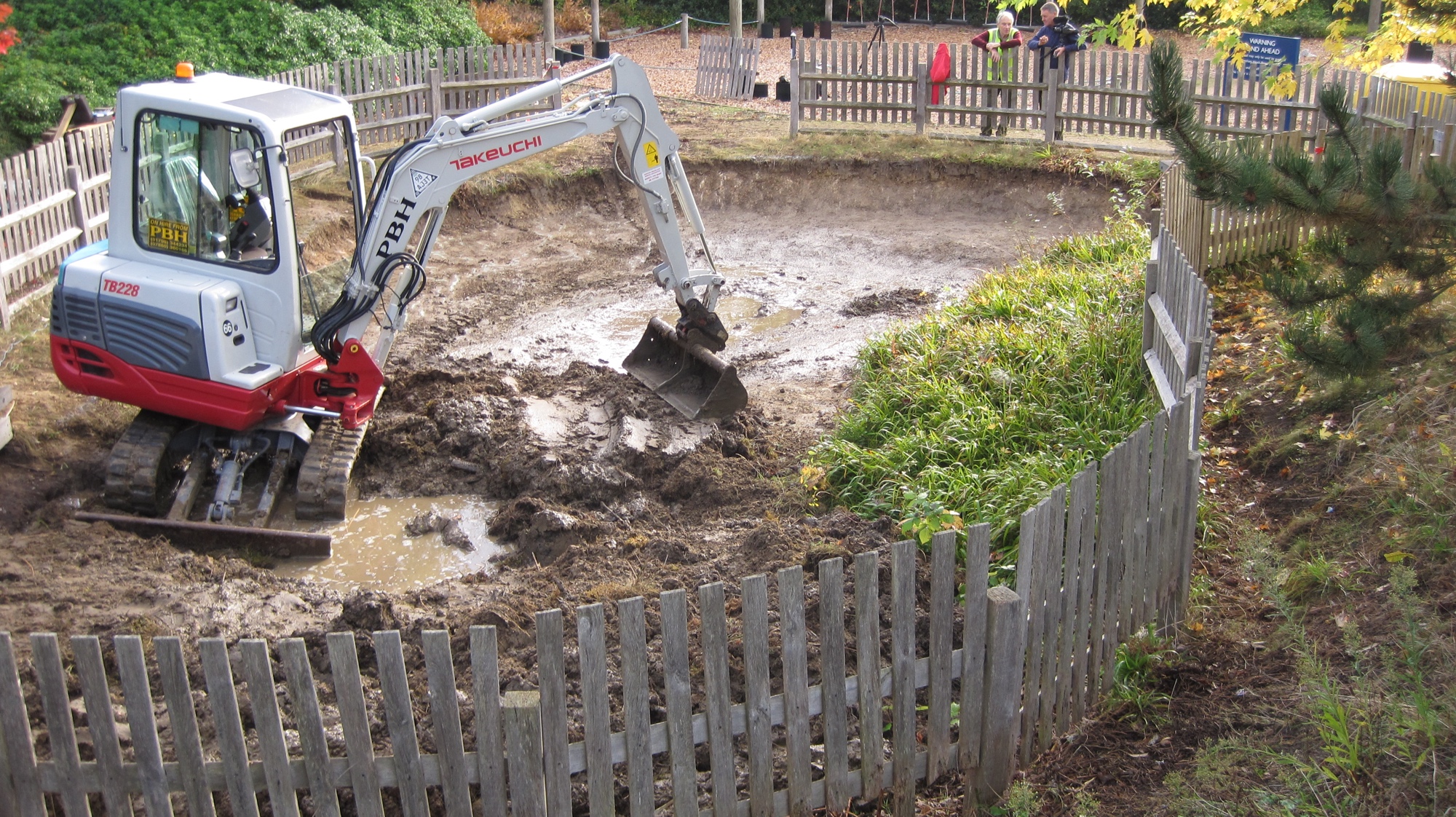
The many water inputs to Fleet Pond (click to enlarge)
Taking a relaxing walk in the natural environment of Fleet Pond, it may seem that the issue of man-made pollution is far removed. Sadly this is not the case, and the consequences of pollution can be a very real problem.
The practicalities are quite complex and so this post goes into them in some detail. An indication of the complexity can be seen in the picture above which shows the numerous water sources leading into the Pond. I’m sure this is a lot more than you might imagine!
Colin Gray, Chairman of Fleet Pond Society, writes:
“There has been much discussion about pollution and how to deal with it during our work towards the restoration of Fleet Pond. This tended to concentrate initially on the vast volume of sand and clay silts brought down the Gelvert Stream as a result of eroded soils at the Long Valley army training lands. The new filters and settlement ponds installed by the Defence Training Estates in 2006 has led to a significant reduction in silt input to Fleet Pond.
It was therefore possible to launch a major dredging programme. New islands and reedbed extensions have been made with the extracted silt and the pond has benefited from areas of deeper water. The islands serve another purpose, that of windbreaks which reduce wind disturbance of silt in the pond. This has helped to create clearer water. The other silt problem associated with the Brookly Stream is the dead and rotting vegetation from trees, parks and gardens through which the Brookly Stream and its associated Fleet Brook flow.
This has been more difficult to solve but the new pond in Brookly Wood will take some of this at times of high water levels in the stream. The Brookly Stream also receives surface drain discharge from the residential areas as far into Fleet town as the Oatsheaf crossroads and overflow from the Basingstoke Canal sluices by Reading Road Bridge.
Pollution affecting Fleet Pond takes many forms. All along the residential side of the Pond road surface water runs into surface drains, the majority of which discharge into the drainage ditch which lies between the rear gardens of the nature reserve and the Pond. This water in turn flows into Fleet Pond via a number of channels. Water from road surfaces bring in chemical pollutants from car exhausts, spilt petrol and oil, wear from tyres and any rubbish dumped or dropped from cars.
Water from gardens, parks and open spaces that are alongside feeder streams to Fleet Pond, like the Brookly Stream and its tributaries, bring in leaves, cut vegetation, fertilisers, herbicides and pesticides.
I asked Thames Water for clarification on what happens to water that flows into surface drains in Fleet town. The answer they gave suggests even more potential sources of pollution:
“Our ops managers in response to your query of the 11th August say the following:
Once in the surface drains, catchpits or oil interceptors (in car parks) remove grit and oil but surface water sewers are not connected to sewage treatment works and so the water inside them does not receive the same level of treatment before it is returned to the river, or in this case, Fleet Pond. We rely on landowners to use chemicals such as fertiliser, pesticides and herbicides responsibly and this is largely controlled by the Environment Agency, not Thames Water.
However, if you see decorators or builders carrying out such activities as washing cement mixers or paint brushes into surface drains it would be of great concern to us and we would advise anyone to let us know straight away by calling 0800 316 9800 24 hours a day if they see evidence of pollution or believe an incident may be imminent”.
This implies that anything tipped into a road surface drain can end up, untreated, in Fleet Pond, something I believe few people realise. Please think carefully what you do with any waste water. In the foul sewer system it is treated; in road surface drains it is not.
To these sources we have to add one more, which is more difficult for us to solve; that of air pollution. Water in Fleet Pond will absorb chemicals like nitrates from the air adding unhealthy chemical pollution to a Pond already under some stress. Rain will wash pollutants out of the atmosphere and into the Pond. This unseen source of pollution is unlikely to lessen as more houses are built and more cars use our congested roads.
Dealing with this wide range of pollutants can be a complex problem. We try to meet this challenge by introducing barriers between the inflow points and the pond itself. Water flowing from the drainage ditch is directed through settlement pools, as at the end of Kenilworth Road and Wellington Avenue, or through reeds as at Chestnut Grove.
At the point where the Brookly Stream enters Fleet Pond a fibrous barrier has been installed to slow water down and deposit pollutants in the Brookly Bay, rather than spread throughout the Pond. This is not ideal but it does have some control. Ideally a reed bed across the Brookly Bay would filter out pollutants but this could result in water backing up the stream at high flows and cause flooding upstream into residential gardens, not a risk we wish to take.”







